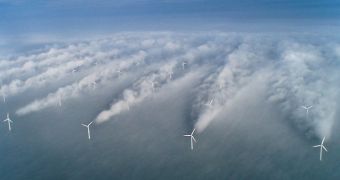Though normally invisible to the human eye, structures called wakes are produced behind wind turbines all the time. Researchers in the United States are now coming together to begin an extensive investigations into the causes and effects of these wakes.
The formations are tremendously similar to the wakes boats leave behind while sailing through water. The only difference is that these disturbances are produced in the air. They however influence the wind turbines behind the one causing the phenomenon.
To keep the analogy, a boat traveling in another's wake experiences an entirely different set of conditions as the boat in the front, which is the first to split the water. Similarly, wind turbines behind the first one in a row have their production influenced by these wakes.
At this point, experts from the US National Oceanic and Atmospheric Administration (NOAA) are teaming up with colleagues from other research groups to begin an in-depth study on the effects that atmospheric wakes have on electricity production levels.
“This turbulence can damage turbines downstream, and harm productivity,” explains atmospheric scientist Bob Banta, who holds an appointment at the NOAA Earth System Research Laboratory (ESRL), in Boulder, Colorado.
Experts from the University of Colorado in Boulder (UCB), the US Department of Energy’s (DOE) National Renewable Energy Laboratory (NREL) and the DOE Lawrence Livermore National Laboratory (LLNL) are also involved in the new work.
In order to recreate the 3D “portrait” of wind speeds and directions in turbine wakes, the collaboration has set up an experiment near Boulder, at the NREL National Wind Technology Center.
“The wake effect has been modeled in wind tunnel studies and numerical models, but the atmosphere is different, it’s more variable and complicated,” Banta explains. He adds that the team expects to analyze wakes some 7 kilometers (4.3 miles) long and 1 kilometer (3,280 feet) high.
“Current-generation wind turbines stretch up into a complicated part of the atmosphere,” explains UCB Department of Atmospheric and Oceanic Sciences professor Julie Lundquist. She also holds an appointment with NREL, and is the leader of the new project.
“If we can understand how gusts and rapid changes in wind direction affect turbine operations and how turbine wakes behave, we can improve design standards, increase efficiency, and reduce the cost of energy,” she goes on to say.

 14 DAY TRIAL //
14 DAY TRIAL //